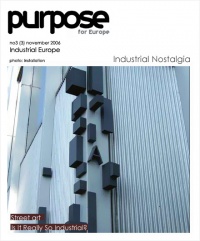
Career in Culture
Atmosphere of nineteenth-century factories
Łódź Art Center (£AC) was established last year to bring together several cultural institutions. Tell me where you got the idea from? Is ŁAC a foundation or an association?
Łódź Art Center is a new cultural institution that aims at pooling together various initiatives in the culture sector. It is a kind of incubator with a lot of space for modern art, photography, theatre, film and music. Legally, we are a foundation.

£AC is located in an old factory complex in Łódź, in Tymienieckiego St. Why there?
Former industrial complexes are the best places to carry out artistic activities. First of all, large factory surfaces can be adapted in many ways, and also this incredible, unique atmosphere of the 19th century factories and Ksiê¿y M³yn (a complex of old factory workers’ houses and a residence of the factory owners), whose renaissance is just starting.
The factory in Tymienieckiego was first offered to the Museum of Artists, but at the moment they are the least visible. Why? The Foundation of Visual Art seems the most active – you are a part of Łódź Art Center, of Art Factory, of Łódź Biennale – does that mean that you are personally involved in all what’s going on in Tymienieckiego?
The majority of events in our factories are the initiatives of Łódź Art Center and the Visual Art Foundation which organized, among other things, five editions of a photographic contest. But the International Museum of Artists are not idle either. They were involved in Łódź Biennale 2006, were the co-authors of Sculpture Park in Manufaktura and of the Construction in Process Museum in our factory complex.

Considering all that – do you regard yourselves as resourceful?
Over a half of the budgets of our companies and events comes from commercial sponsors. Łódź Art Center is based on sponsoring, promotion and efficient PR. I think that our success-stories (The Photographic Contest, Łódź Biennale, The Art Bus) show our resourcefulness.
What is this year’s Biennale like? How does it differ from the 2004 edition?
First of all, it’s mostly devoted to Polish art. On account of the 25th anniversary of the Construction in Process, an artistic movement which dates back to 1981, the majority of the presentations draw from the Polish artistic scene. Although this year there wasn’t a separate international section, world art was presented at several important exhibitions, and we had numerous international visitors.
The factory buildings where Łódź Biennale takes place are old. How do you guarantee the good look and safety of the place?
As other institutions do. We try to raise funds towards the development of the infrastructures in our factories, i.e. heating and fire systems, new wiring, etc. But first of all we made sure that the factories are suitable for exhibitions. We renovated the old floor and painted the walls white. With surfaces so large it was a great financial and organizational effort.

Are old factories the best places for art?
Factories are splendid places to present art. This is the world tendency. Art comes out of small, hermetic galleries of the “white cube” kind and is searching for more natural and universal company.
There are plans to establish the World Art Foundation in Łódź, in the old power station EC1. It is to be another complex to house art and culture. Do you regard it as competition or are you going to cooperate?
We certainly won’t be in competition with the World Art Foundation - they will be rather a valuable partner for us. Łódź is an important art centre on the cultural map of Poland and Europe. So when we, i.e. Łódź Art Center and Art Factory, spread our wings, when the EC1 Centre is launched and the Art Museum moves in a new building, we will be the real art capital of Poland.

We don’t treat it as a race for money. I am sure that in the City budget there will always be money for important initiatives although the extent of this support is disputable.
What advice can you give to other institutions that would like to move in old factories?
This certainly is a great challenge. You have to put a lot of work and invention in it. And the practical advice is that you have to find a strong strategic sponsor or an investor because the maintenance and renovation of old factory spaces is extremely costly. We are still looking for one…
What are your plans for the nearest future?
First of all – exhibitions and theatre productions. Next year we plan to open a permanent art gallery and a performance hall where we are going to perform many entertainments, and where Chorea theatre will be the host.
Check the archive

nr 26 November 2006
theme of the issue:
INDUSTRIAL EUROPE
< spis treści
Article
Industrial Europe
Presentation
Lofts
Anslysis
Industrial nostalgy - Artur Zaguła
Career in Culture
Atmosphere of nineteenth-century factories - conversation with Krzysztof Candrowicz
Industrial Culture
At Scheibler - interview with Dorota Urawska
Young Culture
Street art - conversation with Truth
On the margin
MAXIMALDesign - interview with Gert Verschueren





